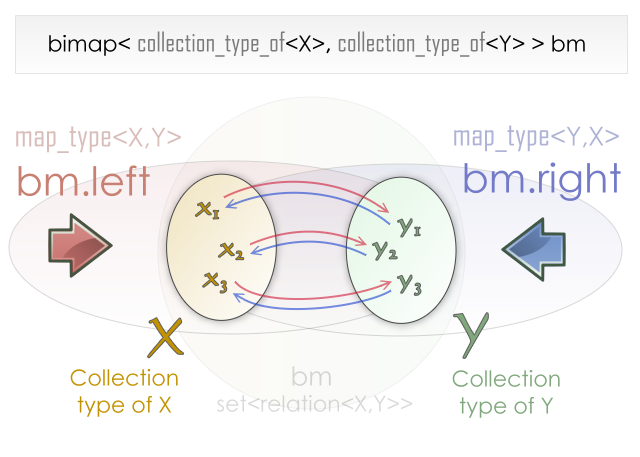 Boost
C++ Libraries
Boost
C++ Libraries
...one of the most highly
regarded and expertly designed C++ library projects in the
world.
— Herb Sutter and Andrei
Alexandrescu, C++
Coding Standards
 Boost
C++ Libraries
Boost
C++ Libraries
...one of the most highly
regarded and expertly designed C++ library projects in the
world.
— Herb Sutter and Andrei
Alexandrescu, C++
Coding Standards
As has already been said, in STL maps, you can only control the constraints from one of the collections, namely the one that you are viewing. In Boost.Bimap, you can control both and it is as easy as using the STL.

The idea is to use the same constraint names that are used in the standard. If you don't specify the collection type, Boost.Bimap assumes that the collection is a set. The instantiation of a bimap with custom collection types looks like this:
typedef bimap< CollectionType_of<A>, CollectionType_of<B> > bm_type;
The following is the list of all supported collection types.
Table 1.2. Collection of Key Types
|
name |
Features |
map view type |
|---|---|---|
|
|
ordered, unique |
|
|
|
ordered |
|
|
|
hashed, unique |
|
|
|
hashed |
|
|
|
sequenced |
|
|
|
random access |
|
|
|
unconstrained |
can not be viewed |
list_of and vector_of map views are not associated
with any existing STL associative containers. They are two examples of
unsorted associative containers. unconstrained_set_of
allow the user to ignore a view. This will be explained later.

The selection of the collection type affects the possible operations that you can perform with each side of the bimap and the time it takes to do each. If we have:
typedef bimap< CollectionType_of<A>, CollectionType_of<B> > bm_type; bm_type bm;
The following now describes the resulting map views of the bidirectional map.
bm.left is signature-compatible with
LeftMapType<A,B>
bm.right is signature-compatible with
RightMapType<B,A>
Each collection type template has different parameters to control its behaviour.
For example, in set_of
specification, you can pass a Functor type that compares two types. All
of these parameters are exactly the same as those of the standard library
container, except for the allocator type. You will learn later how to change
the allocator for a bimap.
The following table lists the meanings of each collection type's parameters.
|
name |
Additional Parameters |
|---|---|
|
|
KeyComp is a Functor that compares
two types using a less-than operator. By default, this is |
|
|
HashFunctor converts a
EqualKey is a Functor that tests
two types for equality. By default, the equality operator is |
|
|
No additional parameters. |
|
|
No additional parameters. |
|
|
No additional parameters. |
We want to store countries populations. The requeriments are:
Lets create the appropiate bimap.
typedef bimap< unordered_set_of< std::string >, multiset_of< long, std::greater<long> > > populations_bimap;
First of all countries names are unique identifiers, while two countries
may have the same population. This is why we choose multiset_of for populations.
Using a multiset_of for
population allow us to iterate over the data. Since listing countries ordered
by their names is not a requisite, we can use an unordered_set_of
that allows constant order look up.
And now lets use it in a complete example
typedef bimap< unordered_set_of< std::string >, multiset_of< long, std::greater<long> > > population_bimap; typedef population_bimap::value_type population; population_bimap pop; pop.insert( population("China", 1321000000) ); pop.insert( population("India", 1129000000) ); pop.insert( population("United States", 301950000) ); pop.insert( population("Indonesia", 234950000) ); pop.insert( population("Brazil", 186500000) ); pop.insert( population("Pakistan", 163630000) ); std::cout << "Countries by their population:" << std::endl; // First requirementfor( population_bimap::right_const_iterator i = pop.right.begin(), iend = pop.right.end(); i != iend ; ++i ) { std::cout << i->second << " with " << i->first << std::endl; } // Second requirement
std::cout << "Population of China: " << pop.left.at("China") << std::endl;
The right map view works like a |
|
The
left map view works like a |
We want to count the repetitions for each word in a text and print them in order of appearance.
typedef bimap < unordered_set_of< std::string >, list_of< counter >> word_counter; typedef boost::tokenizer<boost::char_separator<char> > text_tokenizer; std::string text= "Relations between data in the STL are represented with maps." "A map is a directed relation, by using it you are representing " "a mapping. In this directed relation, the first type is related to " "the second type but it is not true that the inverse relationship " "holds. This is useful in a lot of situations, but there are some " "relationships that are bidirectional by nature."; // feed the text into the container word_counter wc; text_tokenizer tok(text,boost::char_separator<char>(" \t\n.,;:!?'\"-")); for( text_tokenizer::const_iterator it = tok.begin(), it_end = tok.end(); it != it_end ; ++it ) {
++ wc.left[*it]; } // list words with counters by order of appearance
for( word_counter::right_const_iterator wit = wc.right.begin(), wit_end = wc.right.end(); wit != wit_end; ++wit ) { std::cout << wit->second << ": " << wit->first; }
|
|
Because the right collection
type is |
|
When we insert the elements using the left map view, the element is inserted at the end of the list. |